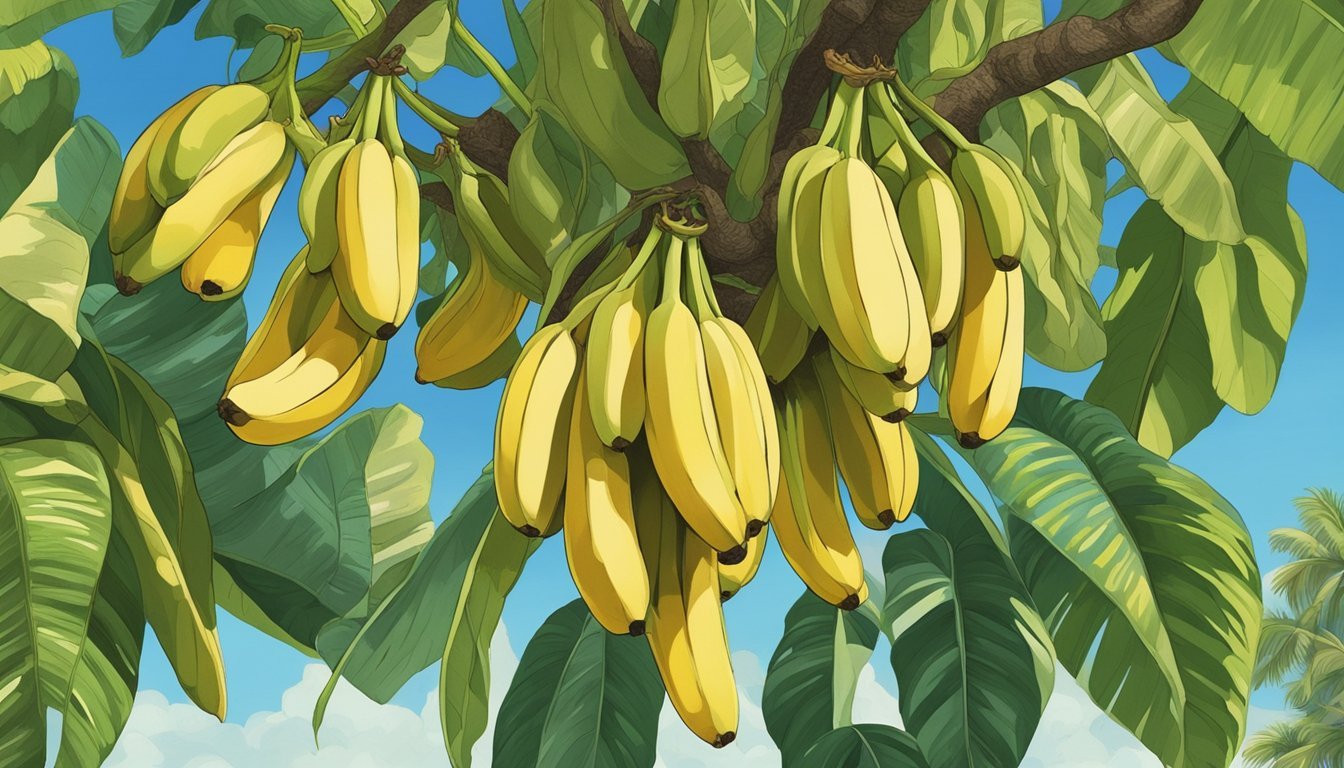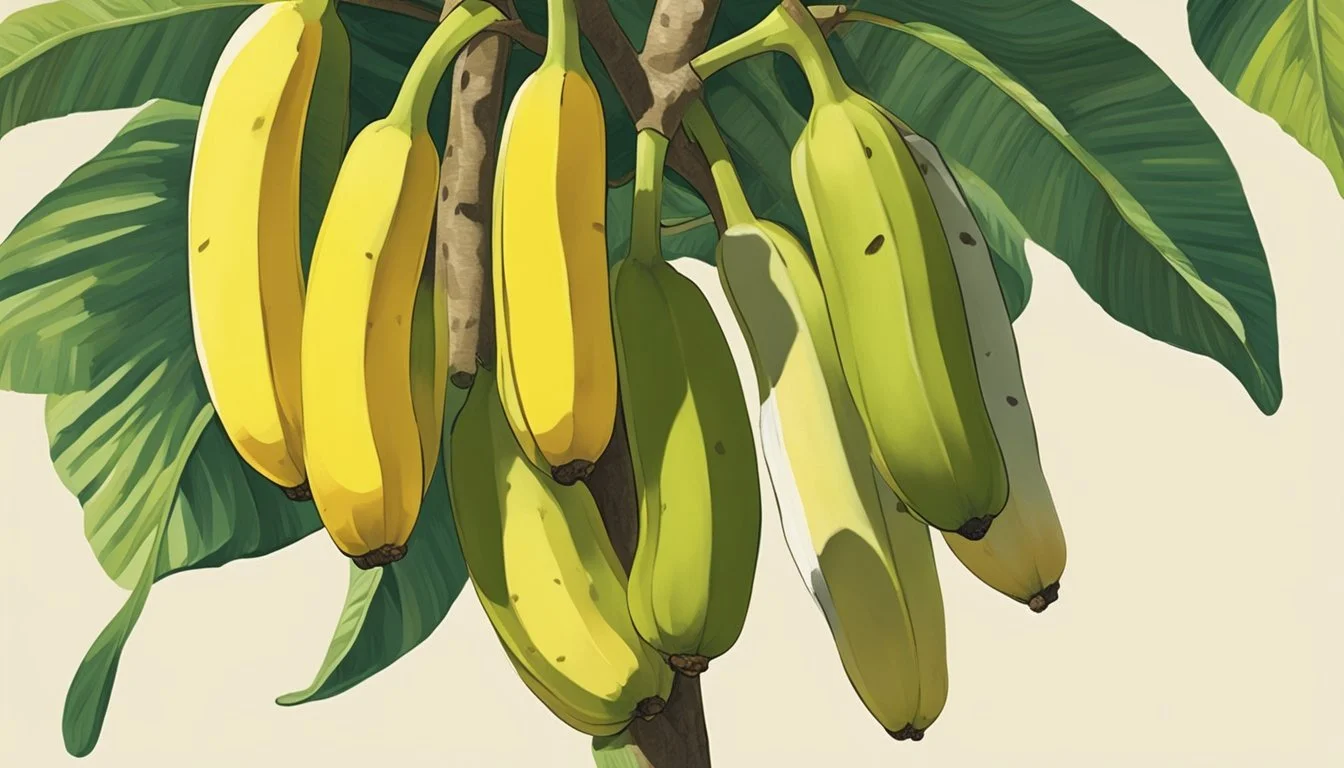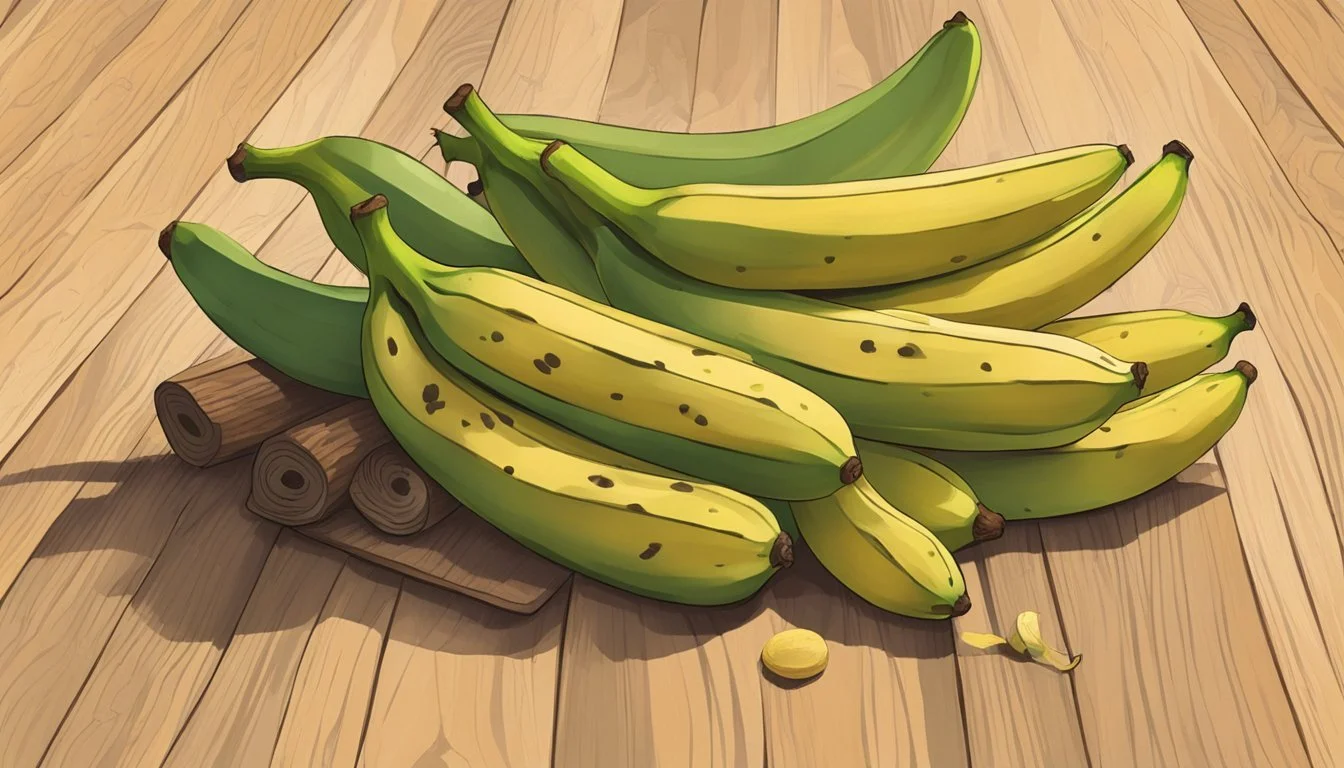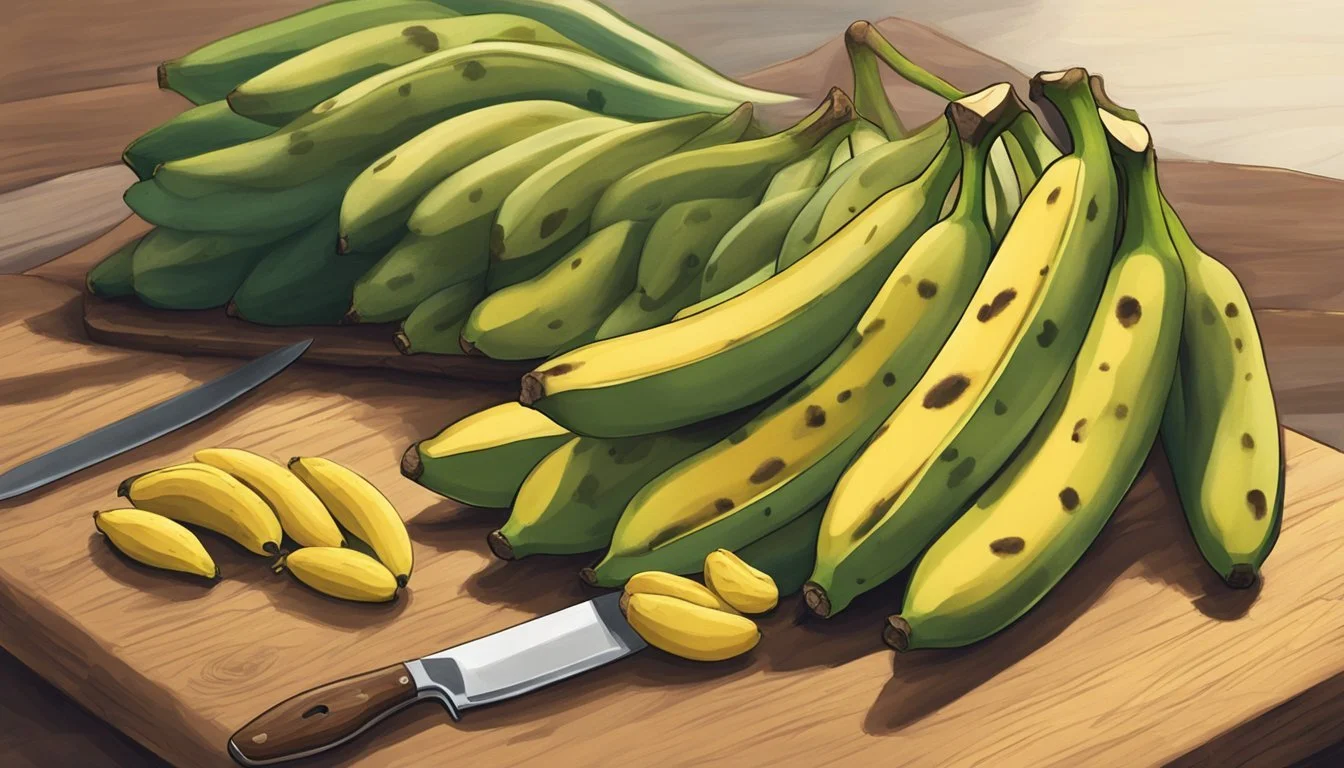How to Tell if a Burro Banana is Ripe
Your Detailed Ripeness Checklist
Determining the ripeness of a burro banana is essential not only for enjoying its unique flavor but also for maximizing its nutritional value. Burro bananas, with their distinct square-like shape, are a type preferred by many for their earthy taste with notes of lemon zest when ripe. Unlike the common bananas found in most supermarkets, burro bananas have specific ripeness indicators. They transition from a green color to a deep yellow with black spots as they ripen.
To gauge the ripeness of a burro banana, one should look for a yellow coloration with brown spots, which signify that the fruit is ripe enough to eat. The texture of the banana is also a telling factor; ripe burro bananas will yield slightly when gently squeezed, indicating softness and readiness for consumption. Understanding these visual and tactile cues can prevent premature consumption when the fruit has a chalky texture and also ensure you don't miss out on the rich, creamy texture that a perfectly ripe burro banana offers.
Key Takeaways
Look for a yellow color with brown spots and a slight give to touch to determine ripeness.
Avoid consuming burro bananas prematurely to prevent a chalky texture and enjoy the ideal creamy taste.
Utilize visual and tactile cues to fully enjoy the distinct flavor and nutritional benefits of ripe burro bananas.
Understanding Burro Bananas
Before delving into how to identify the ripeness of burro bananas, it's essential to grasp their unique origins and nutritional qualities, which separate them from common varieties.
Origins and Characteristics
Burro bananas, originating from South America, are a distinct variety within the Musa acuminata species. These fruits are known for their squarish shape and robust structure. Unlike the elongated and curved shape of most bananas, burro bananas are typically shorter and feature a more block-like form. As they transition from green to a deep yellow with age, their skin develops characteristic dark spots signaling ripening. In terms of texture, unripe burro bananas possess a firm, almost chalky composition which softens considerably as they mature.
Nutritional Profile
The nutritional content of burro bananas makes them a valuable addition to a balanced diet. They offer a substantial amount of fiber and are a good source of potassium, which is crucial for maintaining heart health and proper muscle function. Additionally, burro bananas contain vitamin C, aiding the immune system. Here is a brief overview of their nutritional profile per 100 grams:
Calories: Around 89-120 (depending on ripeness)
Protein: Approximately 1.3 grams
Carbohydrates: Roughly 31.1 grams
Dietary Fiber: About 2.6 grams
Fat: Minimal, typically less than 0.5 grams
Vitamins: They include a range of B-vitamins along with vitamin C.
Minerals: The fruit provides essential minerals like iron, magnesium, calcium, and others in smaller amounts.
These figures offer a concise description, revealing burro bananas to be not only a nourishing fruit option but also versatile in culinary applications.
Identifying Ripeness
Determining the ripeness of a burro banana involves observing color changes, assessing texture and firmness, and noting the aroma and flavor. These indicators provide a clear guide to ensure the fruit is at its peak for consumption.
Color Changes
A burro banana's peel transitions from green to yellow as it ripens. It's important to note that ripe burro bananas can retain a slight green hue. As ripeness advances, black or brown spots begin to appear. The presence of these spots often indicates the banana is ripe, and an increase in spot coverage suggests a higher level of ripeness.
Texture and Firmness
The ripe fruit will yield to gentle pressure without feeling mushy. Initially, burro bananas have a firm texture, but as they ripen, the flesh softens. This change in firmness should be palpable when lightly squeezed. If the banana feels very soft or mushy, it may be overripe.
Aroma and Flavor
Ripe burro bananas emit a sweet, tangy aroma reminiscent of lemon zest. The sweetness intensifies with ripeness, while the flesh develops a creamy texture and rich flavor. Unripe bananas lack this distinct smell and have a more starchy flavor profile, which evolves into a more complex, sweet and tangy taste as the banana matures.
Storing Burro Bananas
When storing burro bananas, maintaining their freshness and extending their shelf life depends on the temperature and ripeness at the time of storage. The ripening process can be managed to ensure peak flavor and texture.
At Room Temperature
Burro bananas should be stored in a cool, dry location at room temperature to encourage even ripening. Ethylene is a natural gas released by bananas which accelerates ripening; therefore, it's best to store them away from other ethylene-sensitive produce. They should not be stored in plastic bags at room temperature as this can promote spoilage.
Green, unripe burro bananas: Best kept at room temperature.
Ripe bananas: Can remain at room temperature but should be eaten or used promptly to prevent overripening.
Refrigerating and Freezing
While refrigeration can slow down the ripening process and freezing can preserve bananas for long-term use, both methods affect burro bananas differently.
Ripe burro bananas in the refrigeration: The skin may darken, but the flesh stays fresh.
Green bananas in the refrigeration: Not recommended as it can disrupt the ripening cycle.
For freezing, burro bananas should be peeled and stored in a sealed container or plastic bag. Frozen burro bananas are excellent for smoothies or baked goods.
Use: Ideal for extended preservation but changes texture, not to be used for fresh consumption.
Culinary Uses
Burro bananas offer versatility in the kitchen due to their unique texture and flavor profile. When ripe, their creamy quality and tangy taste become assets in various culinary preparations.
Cooking and Baking
When cooking or baking, ripe burro bananas contribute a distinct flavor and creaminess. They excel in recipes that require a firm yet tender texture.
Cooking: They can be sliced and added to porridge or mashed for pancakes. Ripe burro bananas also perform well in pies and other desserts where a pronounced banana flavor is desired.
Baking: For baked goods such as breads, cakes, and muffins, these bananas can be pureed to give moisture and sweetness. Using mashed burro bananas in baking results in a rich, moist texture.
Smoothies and Desserts
Ripe burro bananas are ideal for smoothies and desserts thanks to their creamy consistency.
Smoothies: Blend them with fruits like strawberries or mangoes to create a rich, flavorful drink.
Desserts: They can be incorporated into cakes or used to make banana chips for a crunchy treat. Incorporating ripe burro bananas into desserts enhances richness and imparts a refreshing twist.
Salads and Snacks
Ripe burro bananas can be a unique addition to savoury dishes.
Salads: Their tangy taste adds a surprising element to a fruit salad or as a topping in green salads.
Snacks: For a quick snack, one can slice and bake the bananas to create homemade banana chips. Ripe burro bananas may also be cut and added to snack mixes for texture and flavor.
Health and Dietary Benefits
Burro bananas boast an impressive range of health benefits due to their nutrient-rich profile. They contribute to digestive health with their high dietary fiber content, support blood pressure management with essential minerals like potassium, and promote weight management by being low in calories yet satisfactorily filling.
Digestive Health
Burro bananas are a significant source of dietary fiber, which is essential for maintaining a healthy digestive system. This fiber aids in preventing constipation and ensures smooth bowel movements. A single medium-sized burro banana contains about 4-5 grams of fiber.
Blood Pressure Management
These bananas are rich in potassium, a mineral that helps in the regulation of blood pressure. They contribute to heart health by maintaining a balance of fluids in the body and helping to relieve tension in the blood vessel walls.
Weight Management and Nutritional Intake
Burro bananas can be a valuable ally in weight management. They are low in calories, with a medium banana providing around 110 calories while being filling. This balance makes them an ideal snack for those monitoring their caloric intake. Furthermore, they supply essential nutrients without the presence of fat, making them a nutritious part of any diet.
Choosing and Buying
When looking for burro bananas, it's important for shoppers to know not only where to find them but also how to choose the freshest and most flavorful fruit.
Where to Find Burro Bananas
Burro bananas can be purchased at local markets that carry exotic or tropical fruits. Additionally, they are readily available through online retailers such as Miami Fruit and Marx Tropicals. These specialized stores often offer a variety of burro bananas and provide the convenience of delivery.
Selecting Quality Fruit
To ensure the freshness and quality of burro bananas, one should look for fruit that has a thick yellow-green peel. A ripe burro banana may also have a blackish hue. Brown spots on the skin are an indicator of ripeness, as is a slight softness to the touch. When selecting, gently squeeze a banana; it should yield slightly under pressure if it's ripe. Avoid fruit with visible bruises or overly soft spots, which may signal overripeness or spoilage.
Comparison with Other Bananas
In understanding the ripeness of Burro bananas, it is essential to distinguish their characteristics from those of Cavendish bananas and Plantains, as these are among the most commonly consumed varieties.
Burro Bananas vs. Cavendish Bananas
Burro bananas, also known as Orinoco, are distinct in that they are chunkier and have a square-like shape when compared to the Cavendish variety. The Cavendish banana is what most people recognize as the standard banana; they are long, slightly curved, and uniformly yellow when ripe. In terms of taste, Burro bananas become sweet and creamy as they ripen, while Cavendish bananas have a consistent sweet flavor throughout the ripening process.
Texture comparison when ripe:
Burro: Creamy
Cavendish: Soft
Shape and size:
Burro: Short, blocky
Cavendish: Long, curved
Burro Bananas vs. Plantains
Plantains, often categorized along with bananas, are more similar to Burro bananas in terms of their sturdiness. However, plantains are longer and have a higher starch content, making them suitable for cooking rather than eating raw when ripe. Conversely, ripe Burro bananas are enjoyed raw, like the Cavendish, but can be used in various culinary applications due to their firmer texture. While both plantains and Burro bananas exhibit a green to yellow transformation as they ripen, plantains typically require cooking to be palatable.
Usage
Burro: Eaten raw when ripe, versatile in cooking
Plantains: Primarily cooked, less often eaten raw
Starch content as they ripen:
Burro: Decreases, becomes creamy
Plantains: Remains high, suitable for cooking
By recognizing these physical and culinary distinctions, consumers can better determine the ripeness and appropriate usage of Burro bananas in comparison to Cavendish bananas and plantains.
In-depth Look at Burro Bananas
Burro bananas boast a distinctive shape and texture, setting them apart from their more common counterparts. This section explores their life cycle, cultivation practices, and the cultural significance attached to their regional varieties.
Life Cycle and Cultivation
Burro bananas have a distinct life cycle that begins with planting the suckers from mature banana plants. These tropical fruits thrive in warm, humid climates such as those found in Central and South America, the Caribbean, Africa, and Southeast Asia which are the regions of their extensive cultivation. They require rich, well-draining soil and plenty of sunlight to grow. The plants can reach heights of 2.5 to 4.5 meters and produce flowers that eventually develop into the fruit. It takes approximately 3 to 8 months for burro bananas to reach maturity after the flowers have appeared.
Regional Varieties and Cultural Importance
There is a breadth of banana varieties grown around the world, with burro bananas being one of many regional varieties that hold cultural significance. Specifically, in countries across Central and South America and the Caribbean, burro bananas are an integral component of the diet and are often featured in traditional dishes. In Southeast Asia, bananas are not only a staple food but also have cultural and religious importance. The regional diversity of bananas, including burro bananas, is vital to both local economies and diets, contributing to the cultural fabric of societies where these fruits are grown and consumed.
The Complete Guide to Burro Bananas
Burro bananas, known for their square-like shape and sturdy constitution, are a variety much distinct from the common Cavendish banana. They are also referred to by various names such as Saba, Bluggoe, Orinoco, Horse, Largo, and Hog. A ripe burro banana typically adopts a deep yellow color with the presence of brown spots. These spots are indicative of natural sweetness, contributed by fructose and sucrose.
Identifying Ripeness:
Color: Yellow with brown spots
Texture: Gives slightly under pressure
Sweetness: Increased with more brown spots
When it comes to cooking, burro bananas offer versatility. Their creamy texture and moisture content make them excellent for baking; they can be used to add natural sweetness and moisture to cakes, breads, or muffins. For a tropical-inspired dish, one could slice the banana and grill or roast it, which enhances its natural flavors.
Culinary Uses:
Smoothies: Blend with fruits for a nutritious drink
Grilled/Roasted: Enhance natural flavors with heat
Baking: Substitute for added sweetness and moisture
Texture Evolution:
Unripe: Chalky, potato-like texture
Ripe: Creamy and suited for varied preparations
In savory dishes or desserts, the creamy texture and orange sweetness of a ripe burro banana complement natural cooking methods, offering cooks an alternative to conventional bananas. To maximize its attributes, chefs should ensure the bananas are ripe, optimizing the fructose and sucrose levels, which provide a balanced sweetness suited for culinary exploration.







